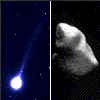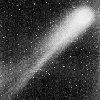
 Small Bodies
Small Bodies

 Ion Tail
Ion Tail
The well-developed tail structure of Comet Halley was captured in this
image taken March 5, 1986. At this point in its orbit, Halley had
recently passed perihelion on February 9, 1986 and was at its most
active. This 10-minute exposure was recorded at Mauna Kea Observatory
on IIIa-J emulsion without filters. This image shows both the ion and
dust tail, with the latter stretching for over 6 degrees on the sky.
 Detachment Event
Detachment Event
One of the more spectacular changes recorded for Halley during an
apparition was the detachment event that happened April 12, 1986. This
3-minute exposure was taken using the Michigan Schmidt telescope at
Cerro Tololo Interamerican Observatory. The resulting image clearly
shows part of the ion tail structure detached from the comet. At this
period, the orientation of the comet is such that the tail is
foreshortened, with the prolonged radius vector pointing west of north.
 Ray Structure
Ray Structure
An example of the ray structure of Halley was captured on March 19,
1986, at the Mount Wilson/Las Campanas Observatories. This 10-minute
exposure was recorded at the focus of the 100-inch telescope on Las
Campanas in Chile. The close-up image, covering the inner 1 degree of
the comet, shows a prolonged radius vector extending to the left.
 Ida
Ida
This mosaic of the asteroid 243 Ida was acquired by the Galileo
spacecraft just before the spacecraft made its close approach to the
asteroid on August 28, 1993. Ida appears to be about 52 km (32 mi) in
length and is irregularly shaped. This view shows numerous craters,
including many degraded craters, indicating Ida's surface is older than
previously thought. Galileo flew within about 2400 km (1500 mi) of Ida.
 Chondrite Meteorite
Chondrite Meteorite
This meteorite was collected from the Allan Hills in
Antarctica. Meteorites are bits of rock that are captured by a planet's
gravity and pulled to the surface. This meteorite is of a type named
chondrite and is thought to have formed at the same time as the planets
in the solar nebula, about 4.55 billion years ago.
 Achondrite Meteorite
Achondrite Meteorite
Discovered at Reckling Peak, Antarctica, this type of meteorite is
known as an achondrite. It has a basaltic composition and was probably
formed when an asteroid melted about 4.5 billion years ago. The
asteroid broke up some time later and this small piece of the asteroid
was captured by Earth's gravity and fell to the ground.
 Iron Meteorite
Iron Meteorite
This iron meteorite was found at Derrick Peak, Antarctica. This type of
meteorite gets its name because it is mostly made of the elements iron
and nickel. This sample is probably a small piece from the core of a
large asteroid that broke apart.

 Welcome to the Planets Home Page
Welcome to the Planets Home Page


 Small Bodies
Small Bodies
 Ion Tail
Ion Tail  Detachment Event
Detachment Event  Ray Structure
Ray Structure  Ida
Ida Chondrite Meteorite
Chondrite Meteorite  Achondrite Meteorite
Achondrite Meteorite  Iron Meteorite
Iron Meteorite 